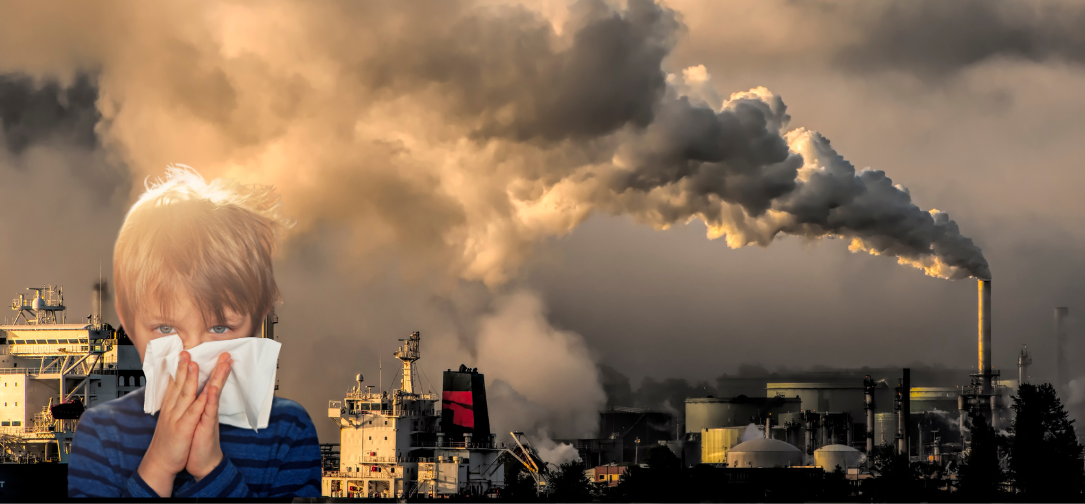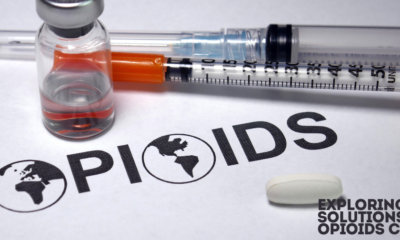Public Health
Air Pollution and Respiratory Health: Protecting Yourself and Your Family

Air pollution is an invisible menace that affects millions of people worldwide. Its insidious effects go beyond the obvious smog-filled skies or the industrial chimneys belching out dark clouds. Air pollution poses a serious threat to human health, particularly respiratory health, and its impact is felt globally. This article delves deep into the relationship between air pollution and respiratory health, examines the sources and types of air pollutants, and provides actionable steps to protect yourself and your family from its harmful effects.
Understanding Air Pollution: What Are We Breathing?
Air pollution is the presence of harmful substances in the air we breathe. These substances, known as pollutants, can come from natural sources, like wildfires and dust storms, or from human activities, such as burning fossil fuels, industrial processes, and agricultural activities. Air pollution is usually classified into two major categories: outdoor (ambient) air pollution and indoor air pollution. Each type has its own set of pollutants that affect respiratory health differently.
1) Outdoor Air Pollution
Outdoor air pollution refers to contaminants found in the open air. The primary sources of outdoor air pollution include vehicle emissions, industrial activities, power generation, construction, and waste disposal. Some of the key pollutants include:
- Particulate Matter (PM): This refers to a mixture of tiny particles and droplets in the air, including dust, dirt, soot, and smoke. Particulate matter is categorized into PM10 (particles with a diameter of 10 micrometers or smaller) and PM2.5 (particles with a diameter of 2.5 micrometers or smaller). PM2.5 is particularly dangerous because it can penetrate deep into the lungs and enter the bloodstream, causing serious health problems.
- Nitrogen Dioxide (NO₂): This gas is primarily produced from vehicle emissions and industrial processes. Long-term exposure to NO₂ can lead to inflammation of the airways and reduced lung function, especially in children and the elderly.
- Sulfur Dioxide (SO₂): Produced mainly from burning fossil fuels like coal and oil, SO₂ can irritate the respiratory system, causing coughing, shortness of breath, and increased susceptibility to respiratory infections.
- Ozone (O₃): At ground level, ozone is formed when pollutants emitted by vehicles, power plants, and other sources react with sunlight. Ozone is a powerful respiratory irritant that can cause chest pain, coughing, and throat irritation and worsen asthma and other lung diseases.
- Carbon Monoxide (CO): This colorless, odorless gas is produced by incomplete combustion of fossil fuels. High levels of CO can prevent oxygen from entering the lungs and bloodstream, leading to dizziness, confusion, and even death in severe cases.
2) Indoor Air Pollution
Indoor air pollution can be even more dangerous than outdoor air pollution, given that most people spend about 90% of their time indoors. Sources of indoor air pollution include tobacco smoke, household cleaning products, building materials, mold, pet dander, and cooking with solid fuels. Key indoor air pollutants are:
- Volatile Organic Compounds (VOCs): Found in paints, cleaning agents, pesticides, and building materials, VOCs can cause respiratory tract irritation, headaches, dizziness, and long-term health effects such as liver and kidney damage.
- Radon: This is a naturally occurring radioactive gas that can seep into homes from the ground. Radon exposure is the second leading cause of lung cancer after smoking.
- Formaldehyde: Released from pressed wood products, cigarette smoke, and some household products, formaldehyde can cause respiratory symptoms and has been classified as a human carcinogen.
- Secondhand Smoke: Tobacco smoke is a potent indoor air pollutant that contains thousands of chemicals, many of which are harmful to respiratory health. Exposure to secondhand smoke can lead to asthma attacks, respiratory infections, and even sudden infant death syndrome (SIDS) in children.
- Biological Pollutants: Mold, dust mites, pet dander, and bacteria can all contribute to poor indoor air quality and exacerbate respiratory problems.
The Impact of Air Pollution on Respiratory Health
The respiratory system is the first line of defense against air pollutants. However, continuous exposure to polluted air can overwhelm this defense mechanism, leading to a range of respiratory diseases and conditions.
1) Asthma
Asthma is a chronic respiratory condition characterized by inflammation and narrowing of the airways, leading to wheezing, shortness of breath, and coughing. Exposure to air pollutants such as ozone, particulate matter, and nitrogen dioxide can trigger asthma attacks and worsen symptoms in individuals with asthma. Children living in areas with high levels of air pollution are more likely to develop asthma due to their developing lungs and increased respiratory rates.
2) Chronic Obstructive Pulmonary Disease (COPD)
COPD is a progressive lung disease that makes it hard to breathe. It includes conditions like chronic bronchitis and emphysema. Air pollution is a significant risk factor for COPD, as long-term exposure to pollutants such as PM2.5 and NO₂ can cause chronic inflammation, reduce lung function, and lead to the development or worsening of COPD.
3) Lung Cancer
Air pollution, particularly exposure to fine particulate matter (PM2.5) and certain toxic chemicals like benzene, has been linked to an increased risk of lung cancer. The International Agency for Research on Cancer (IARC) has classified outdoor air pollution and particulate matter as Group 1 carcinogens, meaning there is sufficient evidence to conclude that they cause cancer in humans.
4) Respiratory Infections
Exposure to air pollutants can weaken the respiratory system’s ability to defend against infections, making individuals more susceptible to respiratory infections such as pneumonia and bronchitis. Children, the elderly, and those with pre-existing health conditions are particularly vulnerable.
5) Reduced Lung Development in Children
Children are more vulnerable to the effects of air pollution because their lungs are still developing, and they breathe more air per kilogram of body weight than adults. Studies have shown that long-term exposure to air pollution can lead to reduced lung development and function in children, which can have lasting effects on their respiratory health throughout their lives.
Vulnerable Populations: Who Is at Risk?
While air pollution affects everyone, certain groups are more vulnerable to its harmful effects:
- Children: As mentioned earlier, children are particularly at risk because their lungs are still developing, and they tend to spend more time outdoors, where they may be exposed to higher levels of pollution.
- Elderly Individuals: Older adults are more likely to have pre-existing health conditions, such as COPD, heart disease, or diabetes, which can be exacerbated by air pollution.
- People with Pre-existing Respiratory Conditions: Individuals with asthma, COPD, or other respiratory diseases are more susceptible to the harmful effects of air pollutants.
- Pregnant Women: Air pollution has been linked to adverse pregnancy outcomes, including low birth weight, preterm birth, and developmental delays.
- Low-income Communities: People living in low-income neighborhoods often face higher exposure to air pollution due to proximity to major roads, industrial facilities, and limited access to healthcare services.
Protecting Yourself and Your Family from Air Pollution
While it is impossible to eliminate exposure to air pollution entirely, there are several steps you can take to minimize its impact on your respiratory health and protect yourself and your family.
1) Stay Informed About Air Quality
Monitor local air quality reports, which are often provided by government agencies or weather apps. The Air Quality Index (AQI) is a useful tool that measures the concentration of key pollutants and provides information on the potential health effects. When the AQI is high (indicating poor air quality), limit outdoor activities, especially for vulnerable groups such as children, the elderly, and those with respiratory conditions.
2) Create a Clean Indoor Environment
Indoor air quality can be managed more easily than outdoor air quality. Here are some ways to improve the air quality in your home:
- Ventilation: Proper ventilation is essential to reduce indoor air pollutants. Use exhaust fans in kitchens and bathrooms and keep windows open when the outdoor air quality is good.
- Air Purifiers: Invest in high-efficiency particulate air (HEPA) filters to reduce indoor particulate matter. HEPA filters can capture fine particles, such as PM2.5, and improve indoor air quality.
- Avoid Smoking Indoors: Do not smoke indoors, and ensure that others do not smoke in your home. Secondhand smoke is a significant source of indoor air pollution and poses serious health risks.
- Reduce Use of VOC-Emitting Products: Minimize the use of products that release VOCs, such as certain paints, cleaning products, and pesticides. Opt for low-VOC or VOC-free alternatives whenever possible.
- Control Humidity Levels: Use dehumidifiers and air conditioners to maintain indoor humidity levels between 30% and 50% to prevent mold growth, which can exacerbate respiratory conditions.
3) Limit Outdoor Activities During High Pollution Days
On days when outdoor air quality is poor, try to limit physical activities, especially vigorous exercises that increase the amount of air you breathe into your lungs. If you need to be outdoors, consider wearing a mask designed to filter out fine particles, such as an N95 mask.
4) Use Public Transportation and Carpooling
Reduce your contribution to air pollution by using public transportation, carpooling, or biking. Reducing the number of vehicles on the road can help lower emissions of harmful pollutants like NO₂ and particulate matter.
5) Advocate for Cleaner Air Policies
Get involved in your community and advocate for policies that aim to reduce air pollution, such as stricter emission standards for vehicles and industries, improved public transportation, and the development of green spaces.
6) Plant
Trees act as natural air filters by absorbing pollutants and producing oxygen. Planting trees and creating green spaces around your home can help reduce exposure to air pollution.
7) Protect Vulnerable Individuals
Ensure that vulnerable individuals, such as children, the elderly, and those with respiratory conditions, take extra precautions on days when air quality is poor. This may include staying indoors, using air purifiers, and wearing protective masks.
8) Regular Health Check-ups
Regular health check-ups can help in the early detection of respiratory issues caused by air pollution. Consult healthcare professionals if you or your family members experience symptoms like persistent coughing, wheezing, or difficulty breathing.
Conclusion: A Collective Effort to Combat Air Pollution
Air pollution is a complex and multifaceted problem that requires a collective effort from individuals, communities, industries, and governments to tackle. While it poses a significant threat to respiratory health, understanding the sources and types of air pollutants, along with taking proactive steps to reduce exposure, can go a long way in protecting yourself and your family. It is essential to stay informed, take preventative measures, and advocate for cleaner air policies to ensure a healthier environment for current and future generations. By making conscious choices and taking action, we can reduce the impact of air pollution on our respiratory health and create a cleaner, safer world for everyone.
-

 Press Release6 days ago
Press Release6 days agoNura Labs Files Revolutionary Patent: AI-Powered Wallet Solves the $180 Billion Crypto Staking Complexity Crisis
-

 Press Release4 days ago
Press Release4 days agoGlobal Compound Feeds and Additives Industry Report: Market Expansion and Competitive Insights to 2035
-

 Technology4 days ago
Technology4 days agoWhat to Know Before Switching Cell Phone Network Services in 2025
-

 Press Release2 days ago
Press Release2 days agoCrypto WINNAZ Launches First On-Chain Yield Engine for Meme Coins, Enabling 20x–300x Returns

































